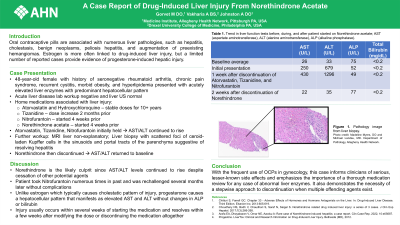Sunday Poster Session
Category: Liver
P1294 - A Case Report of Drug-Induced Liver Injury From Norethindrone Acetate
Sunday, October 27, 2024
3:30 PM - 7:00 PM ET
Location: Exhibit Hall E

Has Audio

Marissa Gorvet, BA, MS, DO
Allegheny General Hospital
Pittsburgh, PA
Presenting Author(s)
Marissa Gorvet, BA, MS, DO1, Aneri Vakharia, BS, MS2, Alexandra M. Johnston, DO3
1Allegheny General Hospital, Pittsburgh, PA; 2Drexel University College of Medicine, Philadelphia, PA; 3Allegheny Health Network Medicine Institute, Pittsburgh, PA
Introduction: Many medications are known to cause drug-induced liver injury (DILI), with antimicrobials, cardiovascular agents, and analgesics being some the most common. Progesterone-only pills (POPs) can also lead to DILI. However, due to the infrequency of this being reported, the prevalence of POPs causing DILI is unknown, but is estimated to be quite low.
Case Description/Methods: A 48-year-old female with history of seronegative rheumatoid arthritis, chronic pain syndrome, recurrent cystitis, morbid obesity, and hyperlipidemia was found to have acutely elevated liver enzymes with predominant hepatocellular pattern of injury. Labs on presentation revealed: AST 250 U/L, ALT 679 U/L, alk phos 52 U/L, total bilirubin < 0.2 mg/dL, INR 1.0. The patient denied alcohol or herbal supplement use. Acetaminophen and salicylate levels were negative. Iron studies, ceruloplasmin, and alpha-1 antitrypsin were non-contributory. Autoimmune testing (ANA, SPEP, anti-mitochondrial antibody) was unremarkable, except for a mildly elevated anti-smooth muscle antibody (1:80). Liver ultrasound was normal. Review of medications revealed that she was on stable doses of Atorvastatin and Hydroxychloroquine for many years, but had a dose increase in Tizanidine two months prior and was started on Nitrofurantoin and Norethindrone acetate four weeks prior. Initially, Atorvastatin, Tizanidine, and Nitrofurantoin were held. However, AST and ALT continued to rise a week later with values of 430 U/L and 1296 U/L, respectively, while alk phos, total bilirubin, and INR remained normal. MRI of the liver was unrevealing. Liver biopsy demonstrated scattered foci of ceroid-laden Kupffer cells in the sinusoids and portal tracts of the parenchyma, suggestive of resolving hepatitis. Norethindrone was discontinued and transaminase levels returned to baseline in two weeks.
Discussion: We concluded that Norethindrone was the culprit agent of this patient’s DILI since transaminase levels continued rising despite cessation of other potential agents. Though Nitrofurantoin is a common cause of DILI, the patient took this medication numerous times in the past and was rechallenged months later without complication. DILI from progesterone is reported less often than estrogen, and unlike estrogen, it typically causes a hepatocellular pattern of injury. With the frequent use of POPs in gynecology, this case informs clinicians of serious, less-known side effects and emphasizes the importance of a thorough medication review for any case of abnormal liver enzymes.
Disclosures:
Marissa Gorvet, BA, MS, DO1, Aneri Vakharia, BS, MS2, Alexandra M. Johnston, DO3. P1294 - A Case Report of Drug-Induced Liver Injury From Norethindrone Acetate, ACG 2024 Annual Scientific Meeting Abstracts. Philadelphia, PA: American College of Gastroenterology.
1Allegheny General Hospital, Pittsburgh, PA; 2Drexel University College of Medicine, Philadelphia, PA; 3Allegheny Health Network Medicine Institute, Pittsburgh, PA
Introduction: Many medications are known to cause drug-induced liver injury (DILI), with antimicrobials, cardiovascular agents, and analgesics being some the most common. Progesterone-only pills (POPs) can also lead to DILI. However, due to the infrequency of this being reported, the prevalence of POPs causing DILI is unknown, but is estimated to be quite low.
Case Description/Methods: A 48-year-old female with history of seronegative rheumatoid arthritis, chronic pain syndrome, recurrent cystitis, morbid obesity, and hyperlipidemia was found to have acutely elevated liver enzymes with predominant hepatocellular pattern of injury. Labs on presentation revealed: AST 250 U/L, ALT 679 U/L, alk phos 52 U/L, total bilirubin < 0.2 mg/dL, INR 1.0. The patient denied alcohol or herbal supplement use. Acetaminophen and salicylate levels were negative. Iron studies, ceruloplasmin, and alpha-1 antitrypsin were non-contributory. Autoimmune testing (ANA, SPEP, anti-mitochondrial antibody) was unremarkable, except for a mildly elevated anti-smooth muscle antibody (1:80). Liver ultrasound was normal. Review of medications revealed that she was on stable doses of Atorvastatin and Hydroxychloroquine for many years, but had a dose increase in Tizanidine two months prior and was started on Nitrofurantoin and Norethindrone acetate four weeks prior. Initially, Atorvastatin, Tizanidine, and Nitrofurantoin were held. However, AST and ALT continued to rise a week later with values of 430 U/L and 1296 U/L, respectively, while alk phos, total bilirubin, and INR remained normal. MRI of the liver was unrevealing. Liver biopsy demonstrated scattered foci of ceroid-laden Kupffer cells in the sinusoids and portal tracts of the parenchyma, suggestive of resolving hepatitis. Norethindrone was discontinued and transaminase levels returned to baseline in two weeks.
Discussion: We concluded that Norethindrone was the culprit agent of this patient’s DILI since transaminase levels continued rising despite cessation of other potential agents. Though Nitrofurantoin is a common cause of DILI, the patient took this medication numerous times in the past and was rechallenged months later without complication. DILI from progesterone is reported less often than estrogen, and unlike estrogen, it typically causes a hepatocellular pattern of injury. With the frequent use of POPs in gynecology, this case informs clinicians of serious, less-known side effects and emphasizes the importance of a thorough medication review for any case of abnormal liver enzymes.
Disclosures:
Marissa Gorvet indicated no relevant financial relationships.
Aneri Vakharia indicated no relevant financial relationships.
Alexandra Johnston indicated no relevant financial relationships.
Marissa Gorvet, BA, MS, DO1, Aneri Vakharia, BS, MS2, Alexandra M. Johnston, DO3. P1294 - A Case Report of Drug-Induced Liver Injury From Norethindrone Acetate, ACG 2024 Annual Scientific Meeting Abstracts. Philadelphia, PA: American College of Gastroenterology.
